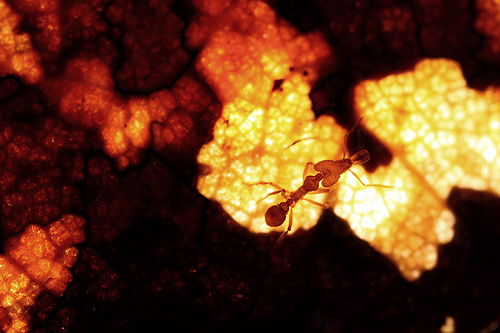A while back, Mike Kaspari asked me if I might be able to produce an image that really captures the essence of the leaf litter ant fauna*. A conceptual shot that would be useful for presentations and the like. It wasn't immediately clear how to do this, as the leaf litter is a dark, dark place. Most of the inhabitants are blind. Not many photons there for a photographer to work with, and lighting it up with a flash sort of kills the native ambiance.
In any case, while in Florida I sat down with a charismatic Strumigenys trap-jaw ant and tried a few things. I came up with this:

Strumigenys rogeri, epitomizing the litter ants
Anyway. What's the deal with leaf litter ants? Why the interest in these little things that most people will never see?
Leaf litter became a new frontier for myrmecologists in the 1980s. New collecting technology had revealed an astounding unknown diversity of species living in the litter. What's more, the sampling techniques were easy to standardize, so that collections from different regions and by different scientists could be compared in a quantifiable statistical framework. The leaf litter fauna brought a lot of myrmecologists together.
I settled on a strategy of backlighting a decaying oak leaf for the image. This technique emphasizes the darkness and complexity of the habitat but also silhouettes an ant foraging through it. I was lucky with this one- the ant was cooperative and it only took me a couple dozen exposures to get a usable photo.
*What are leaf litter ants? They are the (usually) minute ants that live in the decaying debris and rotting wood layered on the forest floor. They aren't a defined taxonomic group but an assortment of ants from different parts of the ant evolutionary tree that have become small, cryptic, and nearly blind as they adapted to live in dank, tight spaces.

Beautiful photo!
Any comment on the BBC story about the world-spanning Argentinian ant colony? They even used one of your photos for the story! I'm interested in hearing your take on it because I'm sure there's a healthy dose of unscientific sensationalism involved.
Nice work, Alex - the backlighting worked a treat. The mosaic of lighter and darker patches fits the 'mood' of leaf litter well.
Erik, I don't know about the particulars, but it is true that the Argentine ants form supercolonies here. They are especially invasive in wetlands - the lake which I live across from is especially depauperate in terms of its ant fauna, probably mostly due to the Argentine ant. And, I wouldn't be surprised if the whole lake and surrounding vegetation was occupied by a 'super colony'.
that's a pretty rad photo
What a piece of art! Did you find any Stenamma in the leaf litter?
nice shot........
*Gasp!*
Eeeeee! I love this photo, it reduces me to adolescent squealing. Wicked.